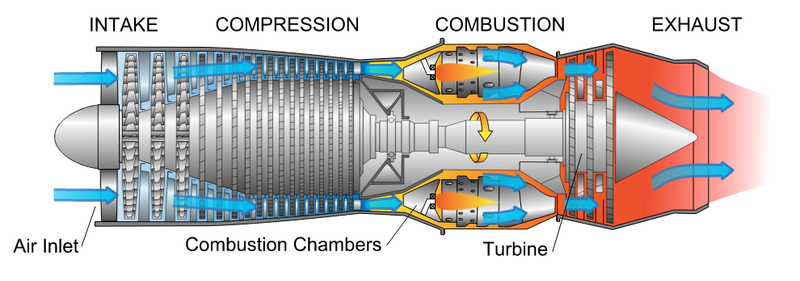Natural gas power plant

Natural gas power plants are a type of power plant that use natural gas as their fuel in order to generate electricity. This process is done using a large gas turbine, where the natural gas is input along with a stream of air which is combusted, and then expands through a turbine causing a generator to spin.
Natural gas power plants have many benefits compared to the other primary energy sources used for generating electricity. They have a lower total cost and are the most efficient of the baseload power providers, and the burning of natural gas is incredibly clean compared to coal and oil.[2] Along with reduced emissions natural gas plants are also able to dispatch quicker than coal-fired power plants, meaning they can be flipped on or off faster in order to meet societies electricity needs.[3]
The use of natural gas accounts for around 23% of the world's electricity generation (see the data visualization below). This is second only to coal, which is the dominant energy source in countries like China and India.
Types
There are two types of natural gas power plants: Simple cycle gas plants and combined cycle gas plants. The former consists of a gas turbine connected to a generator, and the latter consists of a simple cycle plant in combination with another external combustion engine operating on the Rankine cycle, hence its name "combined cycle".
The simple cycle is fairly straight forward yet less efficient than the combined cycle, and is only used for meeting the fluctuating electricity needs of society, known as peaking power. Combined cycle plants make up for the efficiency of simple cycle plants, because it makes use of the hot exhaust gases that are created that would otherwise be dispelled from the system. These exhaust gases are used to boil water into steam, which can then spin another turbine and generate more electricity. The thermal efficiency of the combined cycle can get up to 60%.[4] These plants produce one third of the waste heat of a plant with a 33% efficiency (like a typical nuclear plant or an older coal power plant), see the thermal efficiency page for more information on this.
The cost of combined cycle plants are generally higher, since they cost more to build and run. The EIA estimated that for a simple cycle plant the cost is about US$389/kW, whereas combined cycle plants are US$500 – 550/kW.[5]
Operation
Natural gas turbines are theoretically simple, and have three main parts as seen in Figure 2:[6]
- Compressor- Takes in air from outside of the turbine and increases its pressure.
- Combustor- Burns the fuel and produces high pressure and high velocity gas.
- Turbine- Extracts the energy from the gas coming from the combustor.

Combined cycle
The simple cycle stops here, however the combined cycle extends beyond this to use more of the energy created in the combustion. The exhaust gases are made to flow towards the next unit, called the heat recovery steam generator (HRSG).[8] The HRSG is essentially a heat exchanger, in which the hot gases boil pre-heated water into steam. The steam then expands through a turbine, generating electricity. Once the steam has passed through, it condenses and is recycled through.
World Electricity Generation: Natural Gas
The map below shows which primary energy different countries get the energy to generate their electricity from. Natural gas is seen in red. Click on the region to zoom into a group of countries, then click on the country to see where its electricity comes from. Notable countries include the United States, Russia, Saudi Arabia, and Iran.
References
- ↑ Wikimedia Commons [Online], Available: https://upload.wikimedia.org/wikipedia/commons/2/2e/Surgut_%28060%29.jpg
- ↑ Encana. (June 12 2015). Power generation: Costs [Online]. Available: https://www.encana.com/pdf/natural-gas/power-generation-costs.pdf
- ↑ Encana. (June 12 2015). Power generation: Emissions [Online], Available: https://www.encana.com/pdf/natural-gas/power-generation-emissions.pdf
- ↑ NaturalGas.org. (June 12 2015). Electrical Uses [Online]. Available: http://naturalgas.org/overview/uses-electrical/
- ↑ Paul Breeze. (2005) Power Generation Technologies [Online Book], Available: https://books.google.co.uk/books?id=D9qSDgTbRZoC&pg=PA59&dq=%22Simple+cycle+combustion+turbine%22&hl=en&sa=X&ei=8A4sUYaND4vA9QSSqIDIDw#v=onepage&q=%22Simple%20cycle%20combustion%20turbine%22&f=false
- ↑ Brain, Marshall. "How Gas Turbine Engines Work" 01 April 2000. HowStuffWorks.com. [Online], Available: <http://science.howstuffworks.com/transport/flight/modern/turbine.htm> 28 May 2015.
- ↑ Wikimedia Commons [Online], Available: https://upload.wikimedia.org/wikipedia/commons/4/4c/Jet_engine.svg
- ↑ Wartsila, Combined Cycle Plant for Power Generation: Introduction [Online], Available: http://www.wartsila.com/power-plants/learning-center/technical-comparisons/combined-cycle-plant-for-power-generation-introduction

